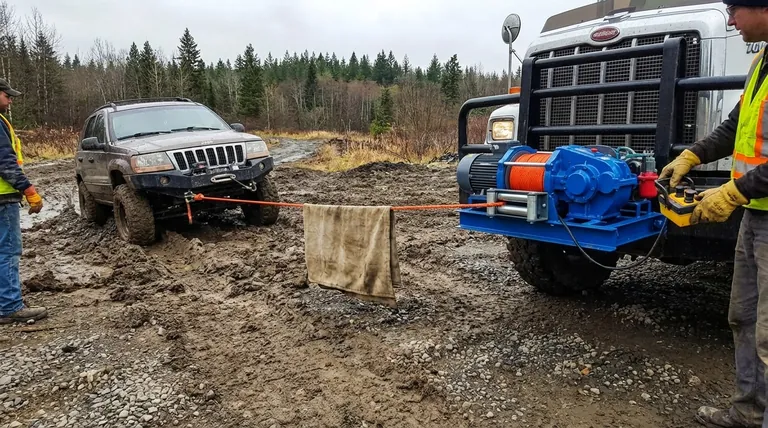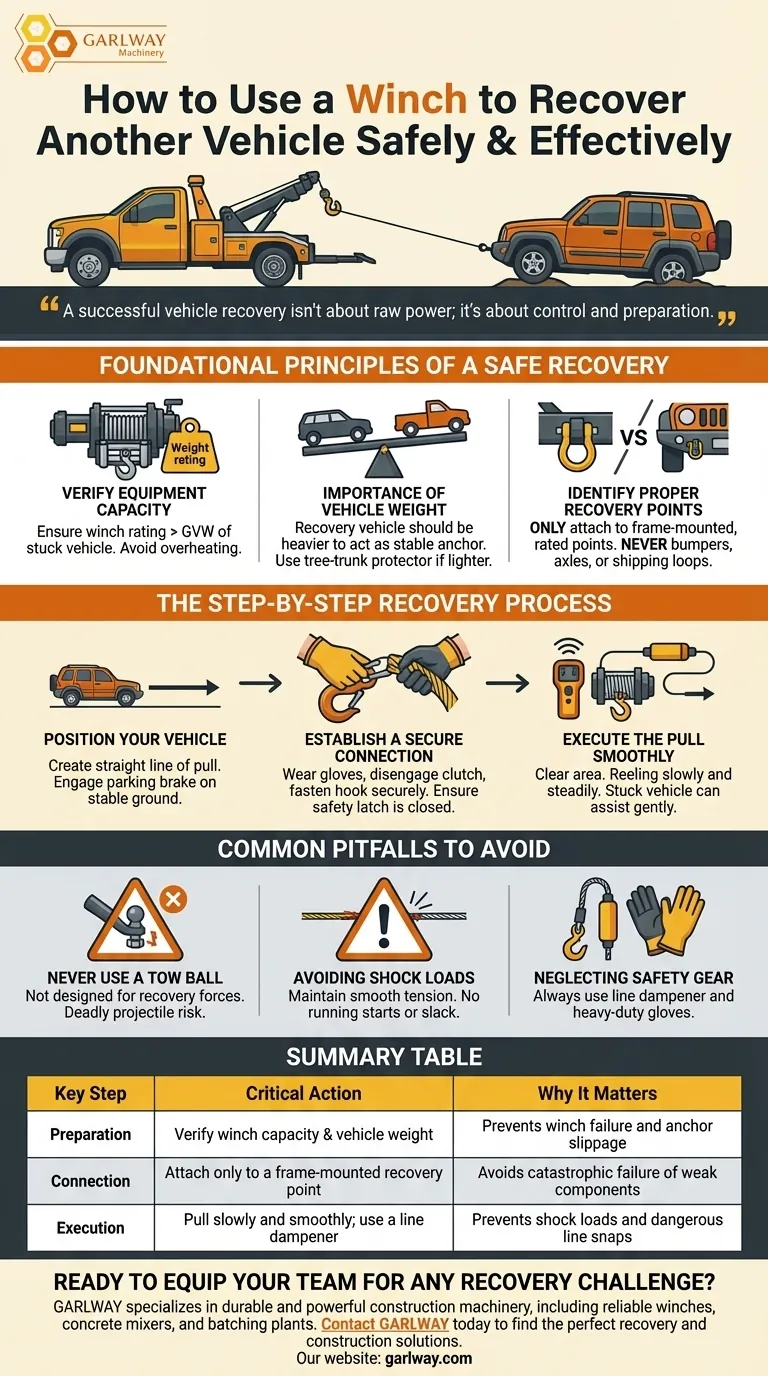To recover another vehicle with a winch, you must first position your own vehicle to serve as a stable anchor for a straight, effective pull. After confirming your winch is rated for the load, unspool the winch line, securely attach it to a proper frame-mounted recovery point on the stuck vehicle, and slowly and smoothly reel the line in to pull them to safety.
A successful vehicle recovery isn't about raw power; it's about control and preparation. The key is to establish a safe, stable anchor with your vehicle and create a straight line of pull to a rated recovery point, minimizing stress on all components.

Foundational Principles of a Safe Recovery
Before you even touch the winch controller, a successful operation depends on a clear assessment of the situation and your equipment. Rushing this stage is the most common cause of failure or accidents.
Verify Your Equipment's Capacity
Your winch has a specific weight rating. This rating must be adequate for the Gross Vehicle Weight (GVW) of the vehicle you intend to pull, not just its curb weight.
An underpowered winch will overheat and fail, potentially causing catastrophic damage.
The Importance of Vehicle Weight
Ideally, the recovery vehicle should be as heavy or heavier than the stuck vehicle. This ensures your vehicle can act as a stable anchor without being pulled forward.
If your vehicle is lighter, you must anchor it to a solid object (like a tree, with a tree-trunk protector) or brace it securely to prevent it from sliding.
Identify Proper Recovery Points
This is a non-negotiable safety step. You must only attach the winch line to a frame-mounted, rated recovery point, such as a D-ring shackle mount or a factory recovery hook.
Never attach a winch line to a bumper, axle, suspension component, or a vehicle's shipping tie-down loops. These are not designed for the immense forces of a recovery and will break.
The Step-by-Step Recovery Process
With the foundational principles understood, the execution of the pull should be methodical and deliberate.
Position Your Vehicle
Maneuver your vehicle to create the straightest possible line of pull between your winch and the stuck vehicle.
Angled pulls put immense stress on the winch drum and can cause the line to spool unevenly, damaging it. Ensure your vehicle is on stable ground with the parking brake engaged.
Establish a Secure Connection
Wearing heavy-duty gloves, disengage the winch clutch and unspool enough line to reach the other vehicle.
Securely fasten the winch hook to the other vehicle’s rated recovery point. Ensure the hook's safety latch is closed and not impeded.
Execute the Pull Smoothly
Clear the area of all bystanders. No one should stand near the winch line during the operation.
Using the winch remote, begin reeling in the line slowly and steadily. The driver of the stuck vehicle can assist by gently applying power in the direction of the pull once the line is taught.
Communicate clearly between both drivers throughout the process. Maintain a slow, consistent pull until the other vehicle is on stable ground.
Common Pitfalls to Avoid
Technical proficiency means knowing what not to do. Avoiding these common mistakes is critical for safety and preventing equipment damage.
Never Use a Tow Ball
A tow ball is designed for sheer load, not the immense shock and pulling forces of a recovery. They can and do snap off, becoming deadly projectiles. Never use one as a recovery point.
Avoiding Shock Loads
A winch line should always be under smooth, consistent tension. Never get a running start or allow the line to go slack and then become taut suddenly. This shock load can snap the line or damage the winch.
Neglecting Safety Gear
Always use a winch line dampener (a heavy blanket or specialized weight) laid over the middle of the line. This will direct the line to the ground if it snaps, preventing it from whipping through the air.
Protective gloves are also essential to prevent severe hand injuries from burrs or frays in the winch line, especially with steel cable.
Applying This to Your Recovery
Your approach should be dictated by the specific scenario, always prioritizing safety over speed.
- If your primary focus is a simple pull from mud or snow: Concentrate on achieving a straight line of pull and maintaining smooth, consistent tension.
- If your primary focus is a heavier or more complex recovery: Double-check that your winch and anchor vehicle are sufficient for the load and consider using a snatch block to increase pulling power.
- If your primary focus is ensuring maximum safety: Clear the area, use a line dampener, and confirm you are connected to a true, frame-mounted recovery point before beginning the pull.
A properly executed winch recovery is a testament to careful planning, not just mechanical strength.
Summary Table:
| Key Step | Critical Action | Why It Matters |
|---|---|---|
| Preparation | Verify winch capacity & vehicle weight. | Prevents winch failure and anchor slippage. |
| Connection | Attach only to a frame-mounted recovery point. | Avoids catastrophic failure of weak components. |
| Execution | Pull slowly and smoothly; use a line dampener. | Prevents shock loads and dangerous line snaps. |
Ready to equip your team for any recovery challenge?
GARLWAY specializes in durable and powerful construction machinery, including reliable winches, concrete mixers, and batching plants designed for demanding job sites. Our equipment gives construction companies and contractors globally the confidence to handle tough situations safely and efficiently.
Contact GARLWAY today to find the perfect recovery and construction solutions for your business needs.
Visual Guide

Related Products
- Electric and Hydraulic Winch for Heavy Duty Applications
- Warn Winch Windlass Boat Trailer Winch
- Electric 120V Boat Winch by Badlands
- Best 18000 Pound Drum Anchor Trailer Winch
- 12000 lb Heavy Duty Electric Boat Winch
People Also Ask
- How do I choose an electric winch? A guide to safe and effective pulling power.
- How does the electric winch work? Unlock the Power of Force Multiplication
- Do electric winches have brakes? Essential Safety for Your Heavy-Duty Pulling
- How to power an electric winch on a trailer? Choose the Best Method for Your Setup
- How to maintain an electric winch? Ensure Peak Performance & Reliability for Your Projects


















